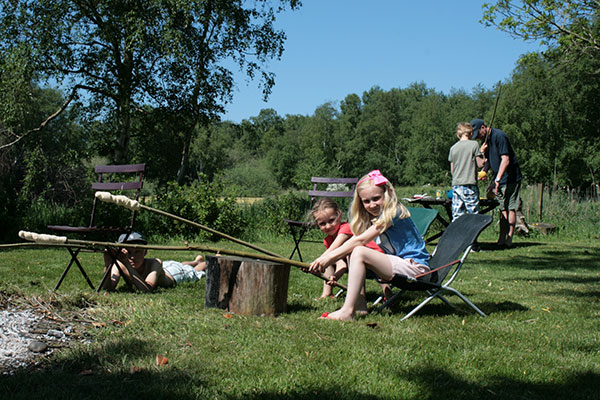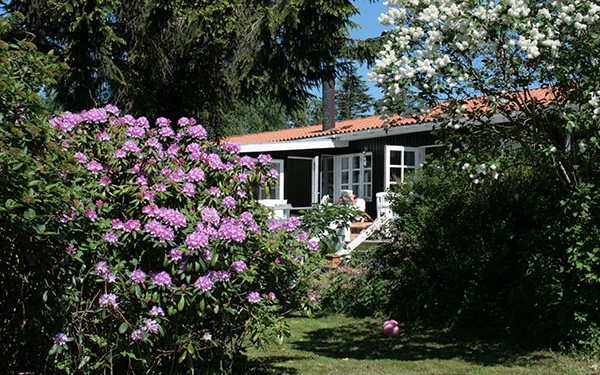Danish Summer houses: An option for this summer’s holiday
This spring or summer you may want to spend your next holiday, or a long weekend, in a Danish summer house.
The article continues below.
Picture and text by Bente D. Knudsen
As a country surrounded by water, you will find that there are plenty of lovely white sandy beaches in Denmark, and it is not surprising that summer cottages are very popular amongst Danes and tourists alike, the Danes love spending time at their house by the sea, their sommerhus.
There are almost 200,000 summer cottages, and more than 40,000 are available for rent.
Why they are still called summerhouses, even when many are used all year and in all kinds of weather, lies in the history of their development.
At the end of the 19th and beginning of the 20th century well off Copenhageners started to move their families out of the city during the summer months, their summer residences were located along the coast north of Copenhagen.
Either on Strandvejen, running from Copenhagen’s outer rim Svanemøllen all the way up to Helsingør, or later along the north Zealand coast from Hornbæk to Tisvilde, also called Kystvejen.
The trend was not limited to Copenhagen; it also took place in other parts of the country, creating for instance the seaside resort of Skagen.
Some of these summer residences were nowhere near the typical ones found today; they were often real mansions, or very large houses and those on Strandvejen are now sold as full year residences at astronomical prices.
The article continues below.
The heydays of building summer cottages
The big sommerhus building boom came during the 1960’s and 1970’s. Danish economy was growing and many citizens wanted a second residence close to the sea where they could spend the summer months.
A great deal of the municipalities along the coastline saw an opportunity to create jobs and encourage tourism, and started allowing the transformation of rural areas, fields and farmland, into summer residential areas.
In addition, Saturday became a day off, making it possible to use the summerhouse also during weekends, thus adding to their popularity.
During this time the summer cottages built were quite simple wooden ones, typically only 40-50 m2, with just two small bedrooms, a living area combined with a small kitchen and a bathroom.
Middle-class families, who were looking for fresh air and more space compared to their city dwelling, often bought these houses.
The article continues below.
Protecting the coastline
It was not until 1977 that a coastal zone law prohibited building right next to attractive coastlines; the three-km protection zone meant that any new summer house area had to be built further inland, at least three km from the coastline.
Today the (relatively) few houses with a sea view are in great demand, making people who own one either pass it on to other family members, or let it go, making a nice profit on the original price.
The development took place all over Denmark; in Jutland on the North tip of Skagen, and along the Atlantic coastline, creating summer towns such as Løkken, Blokhus, Lønstrup or to the south of Aarhus.
Many of the larger Danish islands also have summer house areas such as Samsø, Fanø and Anholt, and of course the most famous one, Bornholm.
The trend since the 80’s has been for larger and more comfortable houses, some with pool and spa facilities, as notably many German families were looking to rent.
Modern summerhouse owner’s want the same level of comfort in their holiday home as they are used to in their main one, so they buy designer furniture, make bigger kitchens with dishwashers and larger bathrooms.
During corona, summerhouse sale boomed and prices surged, in 2023 prices are still high and have not “yet” begun to fall, according to real estate agencies, summerhouse prices have so far resisted the impact of inflation and rising interest rates.
Why only Danish nationals can buy a summerhouse in Denmark
The article continues below.
Neighbouring wealthy countries and an attractive Danish coastline could be the reasons behind the rule.
Therefore, if you do not possess a Danish passport, you are not able to buy a summerhouse. This rule applies to non-EU as well as EU citizens.
Should you wish to do so anyway, you can apply for an exemption from that rule.
It’s the Ministry of Justice who is able to grant a special dispensation to do so. They take into consideration your personal, financial, and other types of attachment to Denmark, as well as any special connections to a particular house.
In recent years around 300 dispensations are given yearly. More than 50 percent of dispensations are given to Norwegian citizens, the next two largest groups are German and Swedish citizens.
Renting a summerhouse in Denmark
The article continues below.
All of the 40,000 summerhouses available for rent are privately owned. Most of them are Danes’ own houses, which are put up for rent a couple of weeks every year.
Some have been converted into luksus huse, luxurious houses with spa and pool, and they are an investment, where the rental incomes help pay off their mortgages.
Recent legislation has made the first 40,000 DKK rental revenue income tax-free, but only if the owner uses a certified agency to rent out.
The government has done this for a number of reasons; one being that the tourist organisations were complaining that they lacked houses to rent out during the attractive high season in the summer, and also to get more control over the black market, as only houses rented out through a certified agency can apply for the tax-free rule.
The article continues below.
Which agency to choose
40 years ago, most summerhouses were rented out by the local tourist organisations.
Today, however, there are a number of large rental agencies with houses available for rent all over the country. There are also a number of regional or local agencies, and the Danish tourist organisations’ local offices.
The Danish trade association for summerhouse rental agencies, Feriehusudlejernes Brancheforening, represents almost 90 percent of all houses put up for rent.
They have made a number of ethical guidelines, which they ask their members (the rental agencies) to adhere to, but they are only guidelines.
So although they recommend holiday seekers only rent a house through their member agencies, at the same time, they have not provided either quality stamps or other quality marks attributed to the houses available for rent through their members. They do have a common complaints board, though, which holiday seekers can contact.
High share of German holiday seekers
For many years, spending the summer holiday in Denmark has had a strong appeal with German middle class families, which is why several of the best-known rental agencies have German websites and German sales consultants available on the phone.
They have names such as Dansommer, Dancenter, Sol and Strand and Novasol. The German language website, fejo.dk, has more than 30 000 houses for rent in their database.
You can also check the Danish website, danishholidayhomes.com, a database of some of the largest Danish rental agencies’ holiday homes. Here you will find the price difference for each home depending on the season.
According to the German magazine Geo Special, the 7000-km coastline and white sandy beaches make Denmark very attractive to German tourists and 80 percent of all rentals are made by Germans.
The article continues below.
Tips for renting
- Book as early as possible, as the popular destinations are quickly sold out (this applies all over Europe though).
- Avoid the school holidays if you can, in Denmark the main weeks are from week 27 to 32, making prices considerably higher.
- The most expensive ones are of course the ones with a sea view, consider if you really need such a location.
- The trade association Feriehusudlejernes Brancheforening recommends their members ensure that someone from their agency is available for at least four hours on the day of arrival and that they have nearby offices open during weekdays. Check your agency’s local office and local office opening hours. The summerhouses are all private homes that can vary in quality and equipment and if you have any questions or complaints, make sure you can get hold of someone from the rental agency.
- You have to add electricity, water consumption and other costs to your rental price. Depending on the season, this can increase your final bill considerably. The trade association recommends that the rental agencies notify possible renters about the average expected extra cost. If they don’t automatically do so, it is a good idea to ask, so you do not get any unpleasant surprises.
- What kind of holiday are you looking for? Do you want just to relax on the beach, have a barbecue and take an occasional bike ride, or do you also want to do some sightseeing and visit bigger cities? Check the location, as some summerhouses are far from any real city life and others can accommodate both. Holiday homes on the smaller islands tend to be quieter and less crowded. Most holiday homes are located in larger holiday home compounds, and if you go in high season, you will find other tourists and Danes on holiday as well.
Why are the Danes so crazy about their summerhouses ?
A Danish summer house owner tells us why;
“For us our summerhouse is a family haven, a special place where the whole family can unwind from the busyness of daily life. We use the house all year around, as we find it equally relaxing to go swimming at the nearby beach, playing in the snow or just having a hot cocoa while the stove spreads warmth during the cold winter months.”
They bought the house at the same time as they had their first born. Both of their children enjoy doing activities in the summerhouse, which they would not do in town.
It is located in a low traffic area, making it easier for the children to run outside and play, ride their bike or skateboard, as well as make sno-brød (which basically means “spinning bread” – as you twist bread dough over a stick) over the open fire in the garden. Often their neighbours are in for the weekend, and both adults and children enjoy meeting up in an informal way.
Expats also have a go’
Brianna Oehmen rented a summerhouse to celebrate her daughters first birthday. As they were gathering quite a crowd, a total of 10 people, with family from Germany joining as well, it had to be a large house. The location was important too, with activities for both young children and grandparents.
“ We used the Danish Holiday Homes site, and found two large ones. We chose the one close to the city of Helsingør, it also had a good view of the beach. As it was in February, the price was great. The whole family thought watching people swimming in the ice cold water was as exciting as Hamlet’s Castle and unpacking presents.”
Support our magazine with a contribution of any size
We do not want to put up a pay-wall, so we need your support and if you find our content relevant and worthwhile, we would value any contribution, however big or small, as a token of your appreciation of our efforts.
How to support:
Transfer any contribution to our bank account at: Your Danish Life/ Danish Expat Media Aps
Danske Bank Account number: 3409 11405673
IBAN: DK68 3000 0011 4056 73
or MobilePay to 2144 1224
Message: Support



